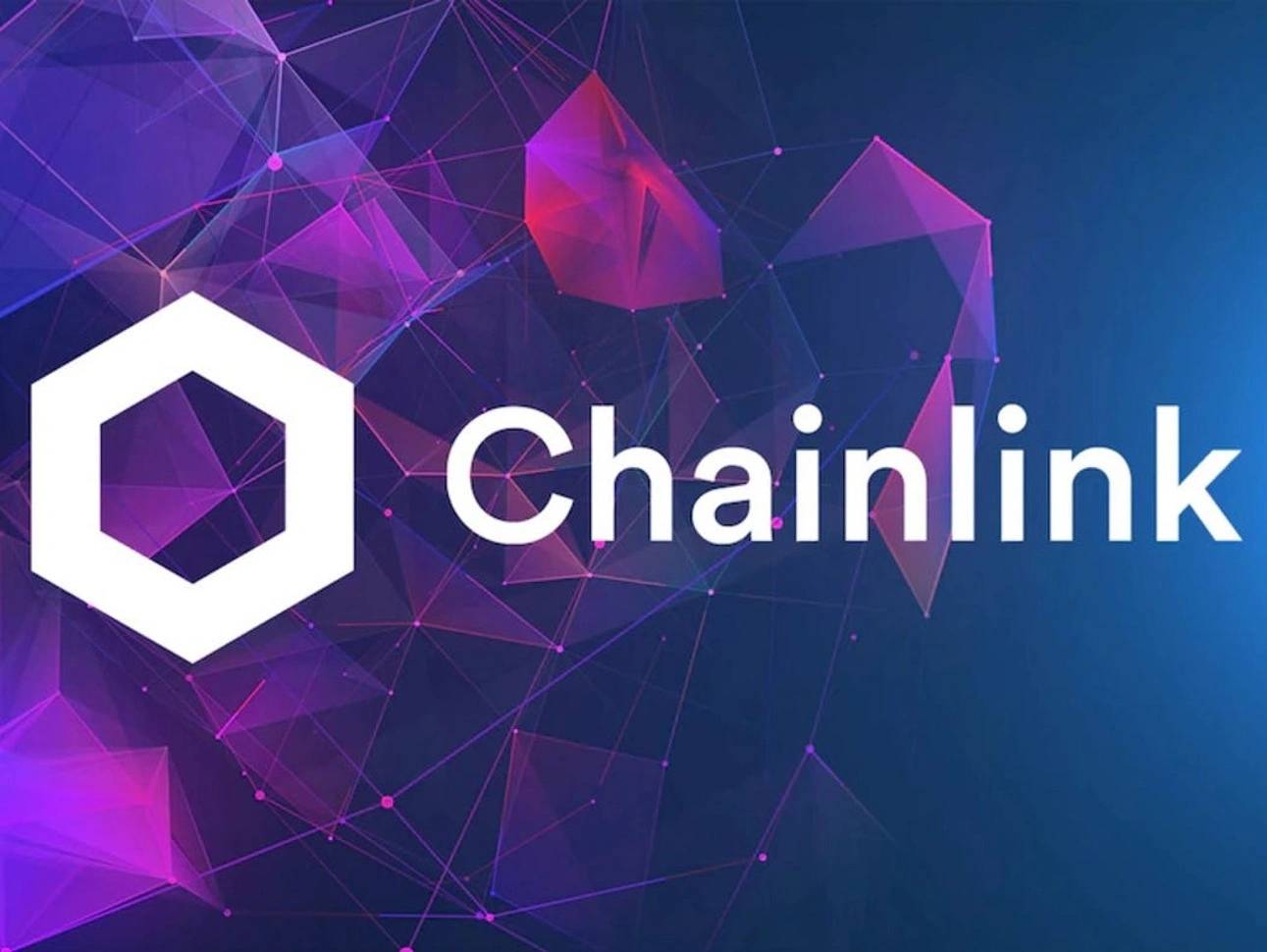위키 구독하기
Share wiki
Bookmark
Chainlink
Chainlink
체인링크(Chainlink)는 오프체인 데이터를 온체인 형식으로 가져오는 탈중앙화 오라클 네트워크로, 고립된 블록체인과 현실 세계 데이터 간의 간극을 해소합니다.[1][2]
역사
체인링크(Chainlink)는 체인링크 랩스(Chainlink Labs, 구 Smart Contract Ltd.)가 개발했으며, 2014년 9월 세르게이 나자로프(Sergey Nazarov)(https://iq.wiki/wiki/sergey-nazarov)와 스티브 엘리스(Steve Ellis)(https://iq.wiki/wiki/steve-ellis)에 의해 설립되었습니다. 현재 이더리움(Ethereum)뿐만 아니라 폴리곤(Polygon)(https://iq.wiki/wiki/polygon), BNB 체인(BNB Chain)(https://iq.wiki/wiki/binance-smart-chain), 애벌랜치(Avalanche)(https://iq.wiki/wiki/avalanche), 아비트럼(Arbitrum)(https://iq.wiki/wiki/arbitrum)과 같은 추가 블록체인 및 레이어 2 네트워크도 지원합니다. LINK는 지분 증명(PoS) 합의 메커니즘으로 보호되는 이 프로토콜의 네이티브 토큰입니다.[3]
2017년 9월 19일, 체인링크는 ICO(initial coin offering)를 통해 3,200만 달러를 모금했습니다. 3억 5천만 개 이상의 LINK 토큰을 판매했습니다. 체인링크는 AccuWeather, FedEx, FlightStats, Associated Press와 같은 다양한 주류 기관들과 파트너십을 맺었습니다. 2021년 10월 21일, Associated Press는 체인링크와 파트너십을 맺어 신뢰할 수 있는 경제, 스포츠 및 경주 데이터 세트를 주요 블록체인에 제공했습니다. 또한, Associated Press와 파트너십을 맺은 IQ.wiki(구 Everipedia)는 체인링크 인프라를 사용하여 2020년 미국 대통령 선거 결과를 최초로 블록체인에 게시했습니다.[72]
2021년 5월 21일, 체인링크 랩스는 Hedera Hashgraph의 분산 거버넌스를 감독하는 헤데라 거버닝 위원회(Hedera Governing Council)의 최초 암호화폐 기반 회원이 되었습니다. 헤데라는 체인링크의 분산형 오라클 서비스를 Hedera 토큰 서비스(HTS)에 통합하고 기본 오라클 솔루션으로 채택했습니다. [102]
2022년 6월 7일, 체인링크 프로토콜은 장기 목표와 새로운 로드맵에 대한 정보를 발표했으며, 이는 네트워크에 대한 "체인링크 경제 2.0" 시대를 열 것입니다. 체인링크는 마침내 네트워크를 보호하고 보상을 받기 위해 LINK 보유자를 위한 스테이킹을 출시할 것입니다.
2022년 기준, 체인링크 생태계는 현재 10억 개 이상의 데이터 지점에 액세스할 수 있으며 700개 이상의 오라클 네트워크에서 1,000개 프로젝트와의 통합을 통해 750억 달러 이상의 가치를 관리합니다.[73][7]
2023년 5월 19일, 체인링크와 Arbitrum은 이더리움의 레이어 2 확장 솔루션인 아비트럼 원(Arbitrum One)에 체인링크 VRF(Verifiable Random Function)를 통합했습니다. 이 협업은 특히 NFT 및 게임 부문에 유익한 아비트럼 플랫폼의 애플리케이션에 대한 무작위성 보안을 향상시킵니다. 이 통합은 블록체인 확장성 및 보안 향상에서 레이어 2 솔루션의 증가하는 역할과 일치하여 분산형 애플리케이션의 혁신과 성장을 촉진하는 것을 목표로 합니다. [104]
2023년 7월 17일, 크로스체인 애플리케이션을 용이하게 하도록 설계된 체인링크의 크로스체인 상호운용성 프로토콜(CCIP)이 Avalanche, Ethereum, Optimism, Polygon을 포함한 여러 블록체인에서 조기 접근 사용자를 위해 출시되었습니다. 이 프로토콜은 Aave 및 Synthetix와 같은 저명한 이름을 포함하여 25개 이상의 파트너와 성공적인 테스트를 거쳤습니다. [101]
개요
체인링크는 여러 블록체인에서 실행되는 스마트 계약에 데이터 스트림을 제공하는 분산형 오라클 네트워크입니다. 외부 소스의 가변 데이터를 사용하여 스마트 계약을 더욱 강력하게 만들고자 합니다.
체인링크 오라클을 통해 스마트 계약은 오프체인 소스에서 데이터를 가져와 블록체인으로 가져올 수 있습니다. 이 혁신적인 개념은 스마트 계약의 새로운 활용 방식을 제시합니다. 예측 시장은 신뢰할 수 있는 소스에서 온체인으로 지식을 집계하는 방법이 중개자를 제거하고 기존 시장을 근절하면서 스마트 계약에 가치를 더하는 한 가지 예입니다. 블록체인은 일반적으로 “신뢰할 수 없는” 네트워크로 작동하도록 설계되었으므로 외부 데이터를 사용하려면 신뢰할 수 있는 소스인 “오라클”과 통합해야 합니다. 분산화를 통해 체인링크 네트워크는 오라클 무결성을 검증하고, 주문 일치를 수행하며, 결과를 집계하여 소싱되는 모든 데이터의 유효성을 보장할 수 있습니다.[4]
체인링크는 모듈식이고 유연하게 설계되었으며, 마이그레이션 기능을 통해 스마트 계약을 업그레이드할 수도 있습니다.
오라클
오라클은 블록체인이 자체 네트워크 외부의 데이터에 접근할 수 있도록 합니다. 신뢰할 수 있는 소스를 통해 실제 상황을 찾고 검증하여 블록체인에 정보를 제출하여 스마트 계약에 사용합니다. 오라클은 스마트 계약 내에서 미리 정의된 조건을 실행하는 데 필요한 외부 데이터를 제공합니다.
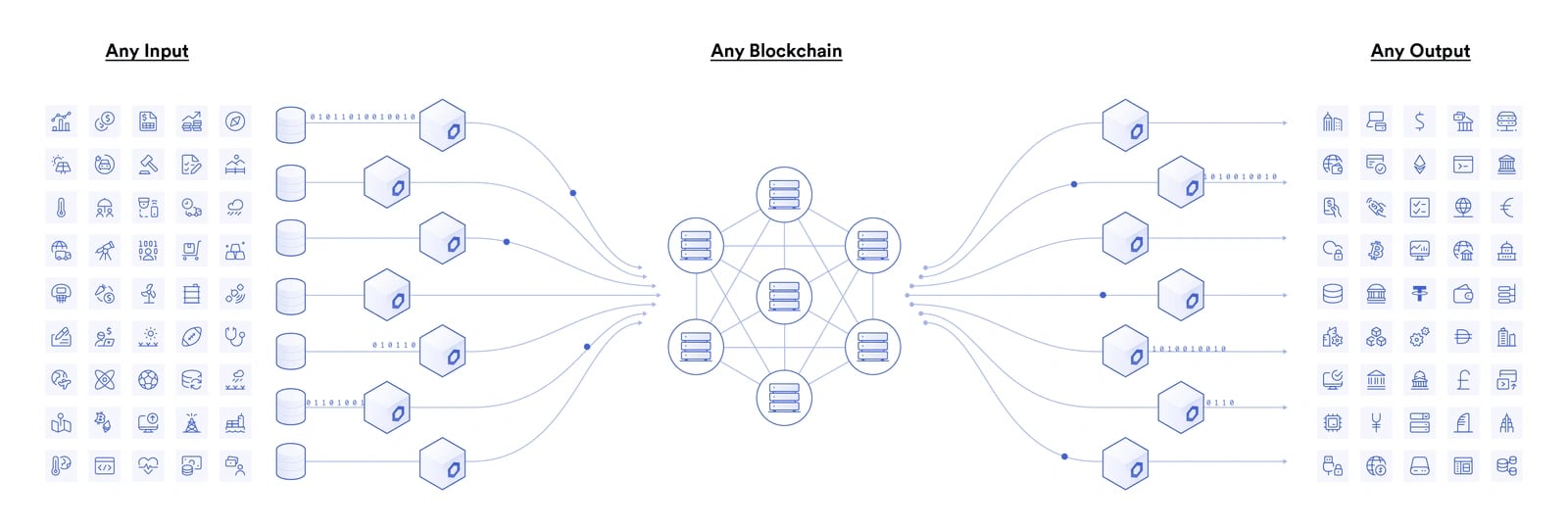
체인링크는 오라클의 신뢰성 여부를 판단하는 어려운 과제에 접근하기 위한 복잡한 프레임워크를 개발했습니다. 오라클은 신뢰할 수 있어야 합니다. 왜냐하면 스마트 계약은 특정 조건에 따라 자체 실행될 수 있기 때문입니다. 부정확한 데이터가 제공되면 스마트 계약이 잘못된 기능을 실행할 수 있습니다.
활용 사례
DeFi
체인링크를 사용하여 누구나 DeFi 앱을 구축할 수 있습니다. 이는 업계 표준 오라클 네트워크이며 DeFi를 위한 것입니다. 탈중앙화 금융 생태계는 체인링크 분산형 오라클 네트워크를 통해 작동될 수 있습니다.
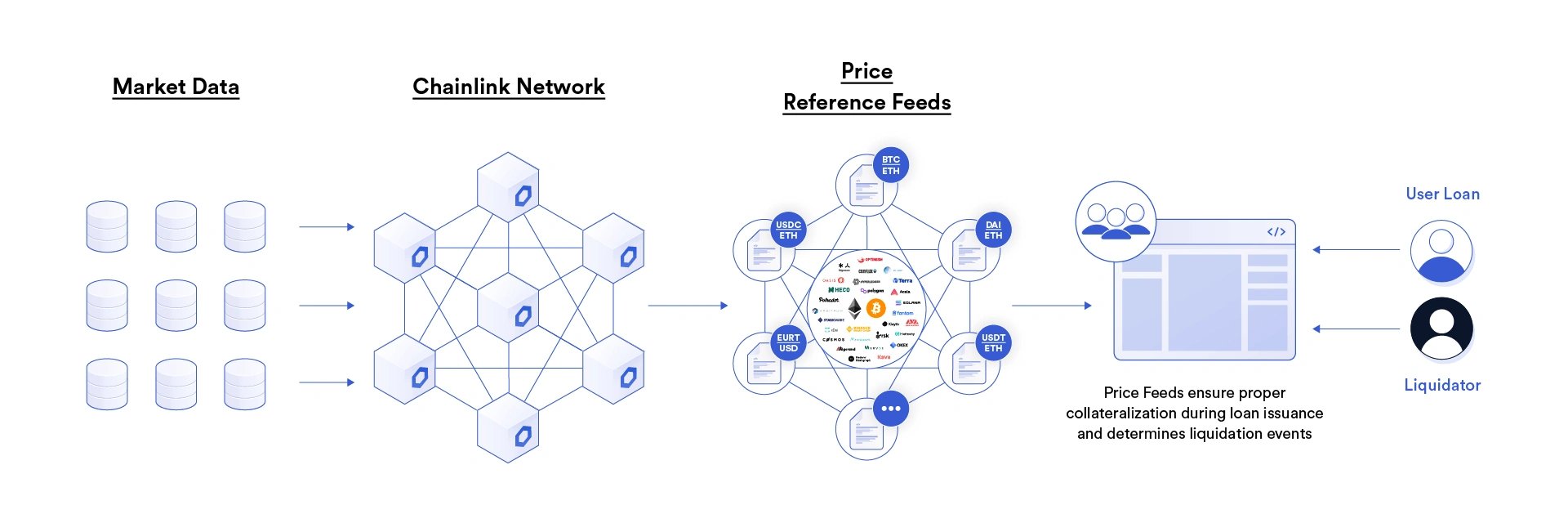
체인링크는 철저하게 검증된 보안 감사 소프트웨어를 실행하는 노드 운영자에 의해 구동되므로 탈중앙화되고 안전합니다. 조작에 대한 저항력이 있으며, 여러 개의 프리미엄 인증 API에서 가져온 고품질 데이터를 집계하여 최종적으로 검증된 답변을 사용자에게 제공합니다. 체인링크는 또한 고품질 데이터와 오프체인 계산을 사용하여 하이브리드 스마트 계약을 연결하며, 이를 통해 DeFi 생태계 내 수십억 달러를 보호하는 데 기여합니다.
체인링크는 다양한 탈중앙화 서비스와 고급 DeFi 애플리케이션의 신속한 통합 및 배포를 제공합니다. 통합된 애플리케이션의 일부는 다음과 같습니다.
기업
체인링크는 기업을 블록체인 경제에 연결하는 업계 표준 미들웨어입니다. 오라클 인프라를 통해 조직은 기존 시스템을 모든 주요 블록체인 네트워크에 안전하고 쉽게 연결할 수 있습니다. 기업은 이제 체인링크를 사용하여 체인링크 노드 형태의 중요한 스마트 계약 인프라를 운영함으로써 새로운 수익원을 창출하고, 안전한 실제 세계 데이터 및 오프체인 계산에 대한 하이브리드 스마트 계약 접근 방식을 제공할 수 있습니다.
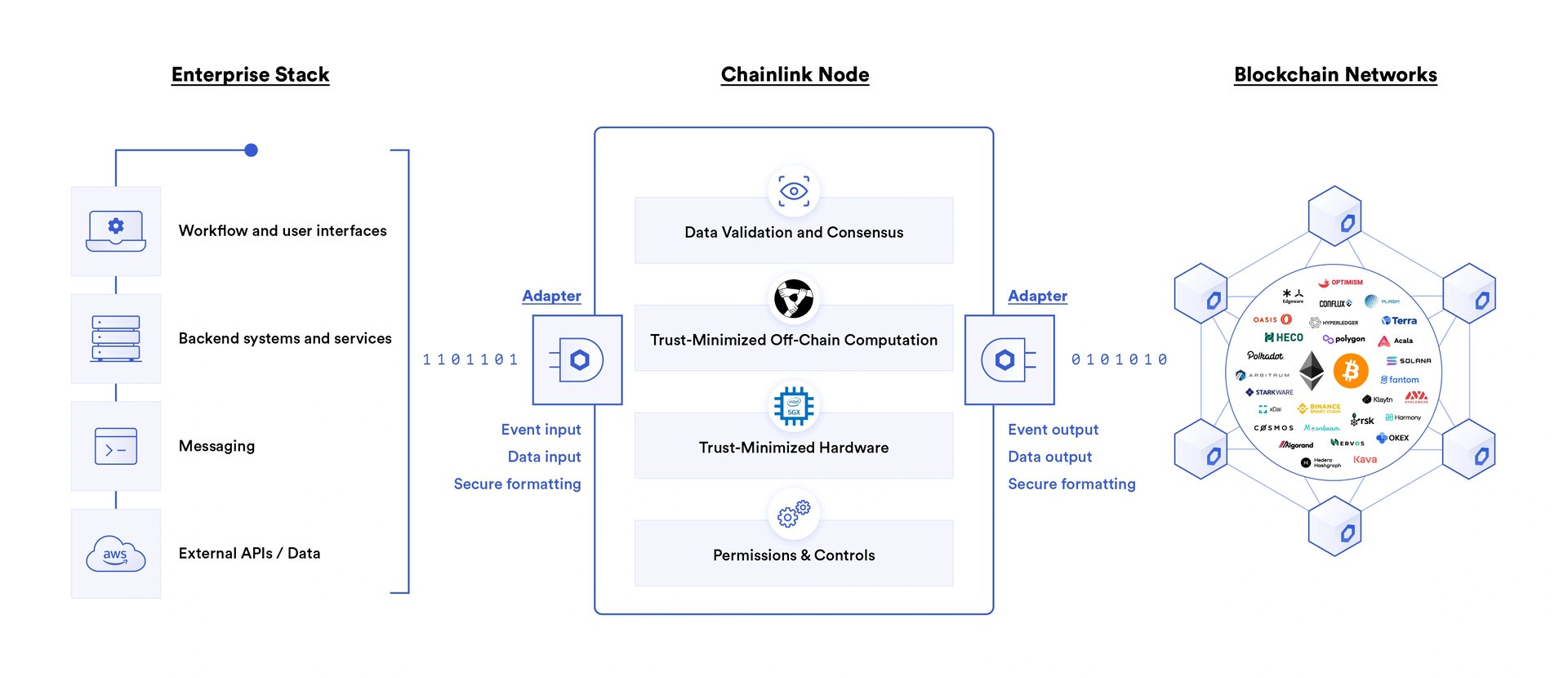
또한 이를 통해 기업은 시스템이 스마트 계약에서 데이터를 읽고 쓰도록 함으로써 블록체인 경제에 접근할 수 있으며, 기업이 기존 워크플로를 안전하게 디지털화하고, 상대방 위험을 완화하며, 중개자 오버헤드를 줄이는 데 도움이 됩니다.[79]
체인링크를 사용하는 기업의 예로는 LexisNexis, Swisscom, AccuWeather 및 The Associated Press가 있습니다.
보험
체인링크는 차세대 블록체인 기반 보험을 구현하는 데에도 사용될 수 있습니다. 탈중앙화 오라클 네트워크는 블록체인 기반 보험 상품이 실제 데이터와 오프체인 컴퓨팅에 안전하게 접근할 수 있도록 합니다. 체인링크를 사용하여 안전한 파라메트릭 보험 상품/애플리케이션을 설계하고, 개발자가 블록체인 기반 보험 프로젝트에 데이터를 판매하여 수익을 창출할 수 있도록 지원할 수 있습니다.[80]
NFTs and blockchain games
Chainlink also supports the integration of NFT and blockchain gaming projects. Its oracles power top NFT and gaming applications across the blockchain ecosystem, helping dApps provide users with dynamic and provably fair gameplay.Users can confirm that their rare and unique digital assets are unique by using Chainlink to ensure that NFT minting, distribution, and trait assignment are done in a provably secure manner. It also brings secure entropy to blockchain games to randomize in-game parameters.
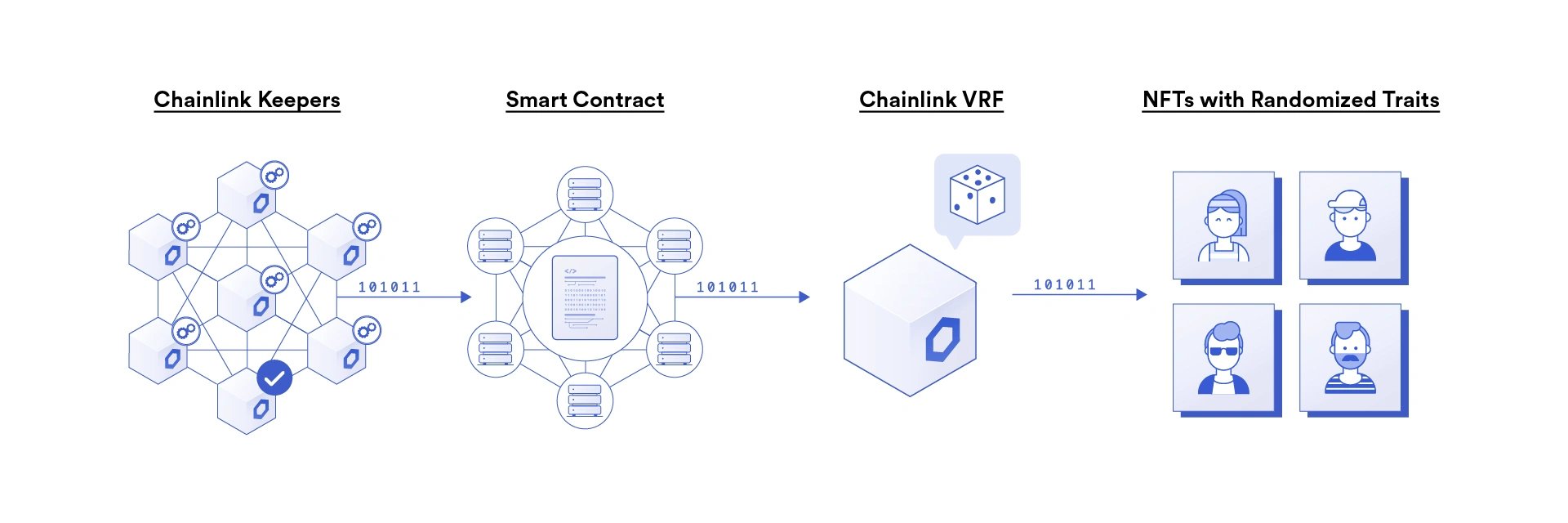
A tamper-proof source of on-chain randomization is provided by Chainlink, enabling an infinite variety of voting procedures to meet the requirements of DAOs for fair decision-making in governance.[81]
사회적 영향
체인링크는 블록체인 혁신을 장려하여 중대한 사회적 변화를 가져오는 데 기여합니다. 체인링크를 통해 사회적 책임 의식을 가진 기관, NGO, 기업 및 기타 기관들은 스마트 계약의 잠재력을 활용하여 금융 포용성, 환경 지속 가능성 및 공공의 이익을 증진할 수 있습니다.
기후 시장
체인링크는 업계 표준 온체인 기후 데이터를 사용자에게 제공하는 것으로 알려져 있습니다. 체인링크 네트워크가 제공하는 엔터프라이즈급 미들웨어는 높은 무결성, 상호 운용성 및 효과적인 기후 시장을 가능하게 합니다.[82]
체인링크 네트워크는 탄소 시장을 연결하고 기후 공약 측정 및 추적에 대한 투명성을 높이는 데 기여합니다.
체인링크 토큰 (LINK)
LINK 토큰은 ERC-20 토큰이며, 추가적으로 transfer(address, uint256, bytes) 기능을 제공하는 ERC-223의 “전송 및 호출” 기능을 갖추고 있습니다. 이를 통해 토큰을 단일 트랜잭션 내에서 계약에 전송하고 처리할 수 있습니다. 체인링크 시스템의 오프체인 요구 사항을 충족하기 위해 LINK 토큰이 노드 운영자에게 지불하는 통화로 설정되었습니다.
개발자에 따르면, LINK 토큰은 이 기능을 수행하는 데 필요하며, 토큰의 수요와 가치는 시스템에 오프체인 서비스를 제공하는 운영자 수와 직접적으로 상관관계가 있습니다. LINK 토큰은 체인링크 플랫폼의 통화로 사용되므로, 체인링크 플랫폼의 사용량이 많을수록 LINK 토큰의 가치가 높아져야 합니다.[5]
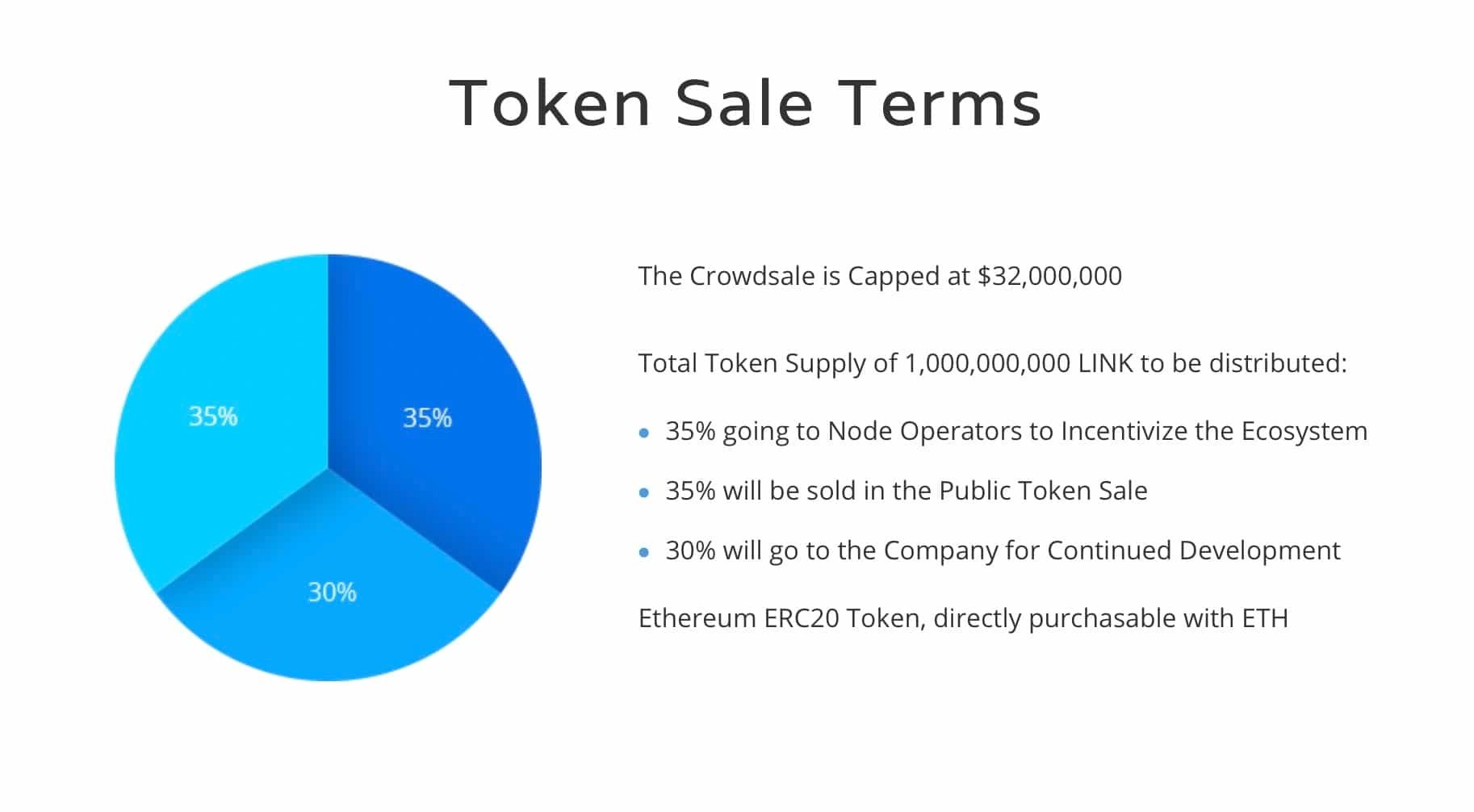
LINK 토큰의 총 공급량은 1,000,000,000 LINK 토큰입니다.
토큰 분배
이니셜 코인 오퍼링(ICO)는 2017년 9월에 진행되었으며, 총 3억 5천만 개의 LINK 토큰이 투자자들에게 토큰당 $0.11에 판매되었습니다. 총 토큰 공급량의 35%는 노드 운영자와 생태계 활성화를 위해 사용될 예정입니다. 또 다른 35%의 LINK 토큰은 공개 판매 이벤트를 통해 배포되었습니다. 마지막으로, 총 토큰 공급량의 나머지 30%는 체인링크 생태계 및 네트워크의 지속적인 개발을 위해 회사에 배정되었습니다.[74][75]
용도
- 내부 결제
체인링크 노드 운영자의 작업에 대한 지불에 사용되는 통화입니다.
- 스테이킹
체인링크 노드 운영자는 네트워크에 스테이킹하여 참여하고 데이터 서비스를 제공해야 합니다. 스테이크가 높은 노드는 요청된 데이터를 제공하도록 선택될 가능성이 더 높습니다.
생태계
데이터 제공자, 노드 운영자, 스마트 계약 개발자, 연구원, 보안 감사자 및 기타 전문가로 구성된 대규모 오픈소스 커뮤니티가 체인링크 생태계를 지원합니다.
데이터 제공자
데이터 제공자는 기존 데이터와 API 서비스를 가장 널리 사용되는 오라클 네트워크에 판매하여 최소 비용으로 신흥 스마트 계약 경제로 비즈니스 모델을 빠르게 확장합니다. 체인링크는 노드 관리 및 암호화폐 결제 처리와 관련된 모든 어려움을 없애주므로, 데이터 제공자는 현재 인프라를 수익화하고 고품질 데이터 제공에만 집중할 수 있습니다.
노드 운영자
체인링크 네트워크의 핵심에는 체인링크 노드 운영자가 있습니다. 이들은 모든 블록체인의 스마트 계약이 안전하게 최고의 실제 데이터에 접근할 수 있도록 필요한 오라클 인프라를 관리하고 유지합니다. 노드 운영자는 모든 블록체인의 스마트 계약에 직접 오라클 컴퓨팅을 제공하고 블록체인의 성공에 필요한 중요한 데이터 인프라를 운영함으로써 수익을 얻습니다.[76]
체인링크 제품
시장 및 데이터 피드
체인링크는 DeFi, 스포츠, 날씨 등 다양한 분야에 분산되고 고품질의 데이터 피드를 제공합니다. 이러한 데이터 피드는 DeFi 및 그 이상의 고유한 스마트 계약 사용 사례를 지원하기 위해 안전하고, 신뢰할 수 있으며, 분산된 오프체인 데이터 소스를 제공합니다.
NFT 바닥 가격 피드
체인링크 NFT 바닥 가격 피드는 특정 NFT 컬렉션의 바닥 가격을 추정치로 제공합니다. 이 피드는 다른 체인링크 데이터 피드와 유사하게 작동하며 Coinbase Cloud의 집계 알고리즘과 체인링크의 오라클 인프라를 활용하여 극단적인 가격 변동을 제거하고 시장 조작으로부터 보호합니다. NFT 바닥 가격 피드는 정확한 NFT 데이터가 필요한 다양한 애플리케이션(예: 대출 및 차용, 온체인 파생상품, 동적 NFT, 게임 길드, CeFi 제품, 예측 시장 등)에 활용될 수 있습니다.[94]
이 피드에서 처음 지원하는 컬렉션은 Azuki Official, Bored Ape Yacht Club(보어드 에이프 요트 클럽), CloneX(클론엑스), Cool Cats(쿨 캣츠), CrypToadz(크립토애즈), CryptoPunks(크립토펑크스), Doodles(두들스), Mutant Apes(뮤턴트 에이프스), Vee Friends(비 프렌즈), 그리고 World of Women(월드 오브 우먼)입니다. 이 피드는 DeFi(디파이)와 NFT(NFT) 경제 간의 간극을 해소하여 체인링크의 신뢰할 수 있는 오라클 인프라를 기반으로 하는 새로운 금융 상품 및 서비스의 생성을 가능하게 합니다. NFT 바닥 가격 피드는 대출 및 차용, 온체인 파생상품, 동적 NFT, 게임 길드, CeFi 제품 및 예측 시장을 포함한 다양한 사용 사례에 사용될 수 있습니다.[95]
체인링크의 NFT 가격 피드는 분산형 오라클 네트워크를 통해 여러 NFT 마켓플레이스의 시장 데이터에 대한 접근 권한을 스마트 계약 및 애플리케이션에 제공합니다. 가격 데이터는 다양한 출처에서 시장 데이터를 수집하고 Coinbase Cloud의 데이터 분석 도구를 사용하여 분석한 다음 결과 데이터를 스마트 계약 및 애플리케이션에 제공하여 생성됩니다. [96]
VRF (Verifiable Random Function, 검증 가능한 난수 함수)
체인링크는 블록체인 게임 및 NFT 프로젝트를 위한 검증 가능하고 위변조 방지 기능을 갖춘 난수 생성기를 제공합니다. 체인링크 VRF는 스마트 계약을 위한 안전하고 공정한 난수 생성기를 목표로 합니다. 이는 난수와 함께 해당 진위를 검증하는 암호화 증명을 생성합니다. 이러한 증명은 사용되기 전에 블록체인에서 검증되어 생성된 난수가 위변조 방지 및 신뢰할 수 있음을 보장합니다. 이 기능은 블록체인 게임, NFT, 작업 할당, 샘플 선택 등 예측할 수 없는 결과가 필요한 애플리케이션에 유용합니다. 난수를 요청하는 방법에는 LINK 토큰으로 자금을 조달하는 구독 계정을 통해서 또는 LINK 토큰으로 난수 요청에 직접 자금을 조달하는 두 가지 방법이 있습니다. [103]
자동화
체인링크는 또한 신뢰할 수 있고 고성능이며 분산된 스마트 계약 자동화 기능을 제공합니다. 이 자동화 기능을 통해 Web3 개발자는 분산 방식으로 주요 스마트 계약 기능을 원활하게 자동화할 수 있습니다.
체인링크 자동화는 분산되고 매우 안정적인 자동화 시스템을 사용하여 스마트 계약 내에서 함수의 조건부 실행을 허용합니다. 수십억 달러의 가치를 보호하는 데 책임이 있는 동일한 외부 노드 운영자 네트워크를 활용합니다. 체인링크 자동화를 사용하면 사용자가 제품을 더 빠르게 출시하는 동시에 중앙 집중식 자동화 스택과 관련된 비용과 위험을 피할 수 있습니다.[91]
준비금 증명
체인링크는 사용자에게 온체인 및 오프체인 준비금에 대한 자율적이고, 신뢰할 수 있으며, 시기적절한 감사를 제공합니다. 체인링크의 준비금 증명(Proof of Reserve)은 암호화된 진실에 기반한 자동 감사를 통해 준비 자산의 신뢰할 수 있고 시기 적절한 모니터링을 가능하게 합니다.
크로스체인 통신 (CCIP)
체인링크를 사용하면 사용자는 빠르고 쉽게 크로스체인 애플리케이션을 구축할 수 있습니다. 크로스체인 상호운용성 프로토콜(CCIP)의 도움으로 프로그래머는 여러 네트워크 간에 메시지를 전송하고, 토큰을 전송하고, 활동을 시작할 수 있는 안전한 서비스 및 애플리케이션을 만들 수 있습니다. CCIP는 국제 송금을 위한 은행 중심의 폐쇄형 네트워크인 SWIFT와의 협력으로 출시되었습니다. 이러한 협력에 따라 CCIP는 SWIFT를 다양한 블록체인 네트워크에 연결하는 데 사용될 것입니다. 체인링크 공동 설립자 세르게이 나자로프(Sergey Nazarov)가 강조했듯이, 현재 진행 중인 이니셔티브는 여러 블록체인과 은행 체인 간의 연결을 구축할 가능성을 가지고 있습니다. [101]
건축
계약 요청 및 인터페이스 요청
체인링크는 외부 데이터를 블록체인으로 가져오는 안전한 블록체인 미들웨어 및 분산형 오라클 네트워크 역할을 합니다. 체인링크 노드는 사용자 계약에서 요청된 데이터 요청에 대한 응답을 반환하는데, 이는 USER-SC로 표시되는 요청 계약과 CHAINLINK-SC로 표시되는 요청 인터페이스로 구성됩니다. 요청 인터페이스는 평판 계약, 주문 매칭 계약 및 집계 계약의 세 가지 주요 계약으로 구성됩니다.[11]
- 평판 계약은 오라클 서비스 제공자의 성능 지표를 추적하여 오라클 서비스 제공자가 신뢰할 수 있는지 여부를 알려줍니다.
- 주문 매칭 계약은 제안된 서비스 수준 계약을 받아 오라클 제공업체의 입찰을 수집합니다.
- 집계 계약은 오라클 제공업체의 응답을 수집하고 체인링크 쿼리의 최종 집계 결과를 계산합니다.
오프체인 아키텍처
체인링크는 독립적으로 오프체인 요청에 대한 응답을 수집하는 오라클 노드 네트워크로 구성되며, 이더리움 네트워크에 연결되어 있습니다. 개별 응답은 요청 계약인 USER-SC에 반환되는 글로벌 응답으로 집계됩니다. 오프체인 아키텍처의 두 가지 주요 구성 요소는 다음과 같습니다.
- 체인링크 코어: 체인링크 노드에서 수행하는 작업은 서브태스크라고 알려진 작업 사양의 형식화된 자산입니다. 각 서브태스크는 특정 작업을 수행한 후 결과를 다음 서브태스크로 전달하고 최종적으로 최종 결과에 도달합니다. 서브태스크에는 HTTP 요청, JSON 파싱 및 다양한 블록체인 형식으로의 변환 등이 포함되지만 이에 국한되지는 않습니다.
- 외부 어댑터: 어댑터를 생성하여 사용자 지정 서브태스크를 정의할 수 있습니다. 어댑터를 사용하면 프로그램 앞에 작은 중간 API를 추가하기만 하면 모든 프로그래밍 언어의 프로그램을 쉽게 구현할 수 있습니다. 체인링크는 JSON을 기반으로 하는 스키마 시스템을 사용하여 각 어댑터에 필요한 입력과 형식을 지정합니다.[76][77]
체인링크 워크플로우
- USER-SC(유저-SC)가 온체인 요청을 합니다.
- CHAINLINK-SC(체인링크-SC)가 오라클을 위한 이벤트를 기록합니다.
- 체인링크 코어가 이벤트를 수신하여 어댑터로 작업을 라우팅합니다.
- 체인링크 어댑터가 외부 API에 요청을 수행합니다.
- 체인링크 어댑터가 응답을 처리하고 코어로 다시 전달합니다.
- 체인링크 코어가 데이터를 CHAINLINK-SC(체인링크-SC)에 보고합니다.
- CHAINLINK-SC(체인링크-SC)가 응답을 집계하여 USER-SC(유저-SC)에 단일 응답으로 다시 전달합니다.
계약 내 집계
탈중앙화는 체인링크(Chainlink) 보안의 핵심 요소입니다. 계약 내 분산된 소스로부터 데이터를 집계함으로써 CHAINLINK-SC는 높은 수준의 신뢰를 얻을 수 있습니다. 네트워크의 무결성을 보장하기 위해 체인링크는 커밋 및 공개 알고리즘을 사용하여 무임승차자를 방지합니다. 이 알고리즘은 오라클이 응답에 대한 CHAINLINK-SC 암호화 커밋먼트를 전송하도록 합니다. CHAINLINK-SC가 충분한 수의 응답을 수신하면, 오라클이 응답을 공개하는 두 번째 라운드를 시작합니다. 커밋과 공개 사이에 지연이 있는 순차적 프로토콜은 오라클이 서로의 응답을 복사하거나 무임승차하는 것을 방지합니다.
오프체인 집계
체인링크는 임계값 서명을 사용하여 데이터를 오프체인에서 집계하는 방법을 제안합니다. 이러한 서명은 Schnorr 서명을 사용하여 쉽게 구현할 수 있습니다. 오라클은 집합적인 공개 키 pk와 O1, O2,..., On 사이에 (t, n) 임계 방식으로 공유되는 해당 비밀 키 sk를 갖습니다. 이러한 공유는 각 노드 Oi가 고유한 비밀/공개 키 쌍 (ski, pki)을 갖는다는 것을 의미합니다.
O1은 pki에 관해 검증할 수 있는 부분 서명을 생성할 수 있습니다. 이를 통해 동일한 값 A에 대한 부분 서명을 임의의 t개 오라클 집합에 걸쳐 집계하여 답변 A에 대한 단일 유효 집합 서명을 생성할 수 있습니다. 시스템의 악의적인 행위자에 대응하기 위해, LINK 토큰 보상 형태의 재정적 인센티브를 제공하는 스마트 계약은 부분 서명에 대해 원본 데이터를 소싱한 오라클만 보상합니다.[2]
Chainlink 2.0 (체인링크 2.0)
2022년 6월 7일, Chainlink Protocol (체인링크 프로토콜)은 장기 목표와 새로운 로드맵에 대한 정보를 발표했습니다. 이는 네트워크의 "Chainlink Economics 2.0 (체인링크 이코노믹스 2.0)" 시대를 열 것입니다.[68][69]
Chainlink 2.0 (체인링크 2.0)을 통해 오프체인 리소스에 접근할 수 있는 하이브리드 스마트 계약을 생성할 수 있습니다. 또한 새로운 시스템은 오라클이 "오프체인 오라클 분쟁을 중재"할 수 있도록 합니다. 확장성과 보안은 새로운 업데이트의 주요 장점입니다.
확장성은 아마도 새로운 시스템의 가장 중요한 부산물일 것입니다. 하이브리드 계약과 오프체인 컴퓨팅을 통해 블록체인은 제한된 온체인 부하로 인해 더 높은 확장성을 달성할 것입니다. 결과적으로 분산형 오라클은 더 높은 처리량과 낮은 대기 시간을 갖게 됩니다. 또한, 슈퍼-리니어 스테이킹을 사용하면 조작이 두 배로 어려워지므로 보안이 크게 향상됩니다.
결론적으로 새로운 시스템은 오프체인 데이터 소싱의 정확성, 가용성 및 보안에 관한 사용자에게 타의 추종을 불허하는 보장을 제공합니다.
2022년 8월 25일, Chainlink Labs (체인링크 랩스)는 Chainlink (체인링크) 공동 설립자 Sergey Nazarov (세르게이 나자로프)와 함께 최초의 Twitter Spaces (트위터 스페이스) 타운홀을 개최했습니다. 그는 Chainlink (체인링크)가 업계 표준 분산형 오라클 네트워크로서의 생성에 중요한 역할을 한 Chainlink (체인링크) 커뮤니티에 감사를 표하며 시작했습니다.[68]
그는 또한 Chainlink (체인링크)가 오라클 네트워크 기반 컴퓨팅의 최고 제공업체가 되고 수십억 달러 규모의 DeFi를 확보하는 것의 중요성과 이러한 성과가 Chainlink Economics 2.0 (체인링크 이코노믹스 2.0)의 길을 열어주는 방법에 대해 설명했습니다.
"Chainlink Economics 2.0 (체인링크 이코노믹스 2.0) 시스템의 목표는 Chainlink (체인링크) 자체를 수십 년 또는 영구적으로 지속 가능하게 만들고 그 지속 가능성과 경제적 성장을 Chainlink (체인링크)가 표준인 산업에서 확보된 더 큰 가치에 연결하는 것입니다." - Sergey Nazarov (세르게이 나자로프)
체인링크 경제 2.0
체인링크의 경제 2.0은 다음에 중점을 둔 프로그램으로 구성됩니다.
- 체인링크 서비스 제공업체에 지불되는 사용자 수수료 증가
- 오라클 서비스의 온체인 및 운영 비용 절감
- 스테이커와 같은 더 광범위한 서비스 제공업체가 생태계에 참여할 수 있도록 지원합니다.[86]
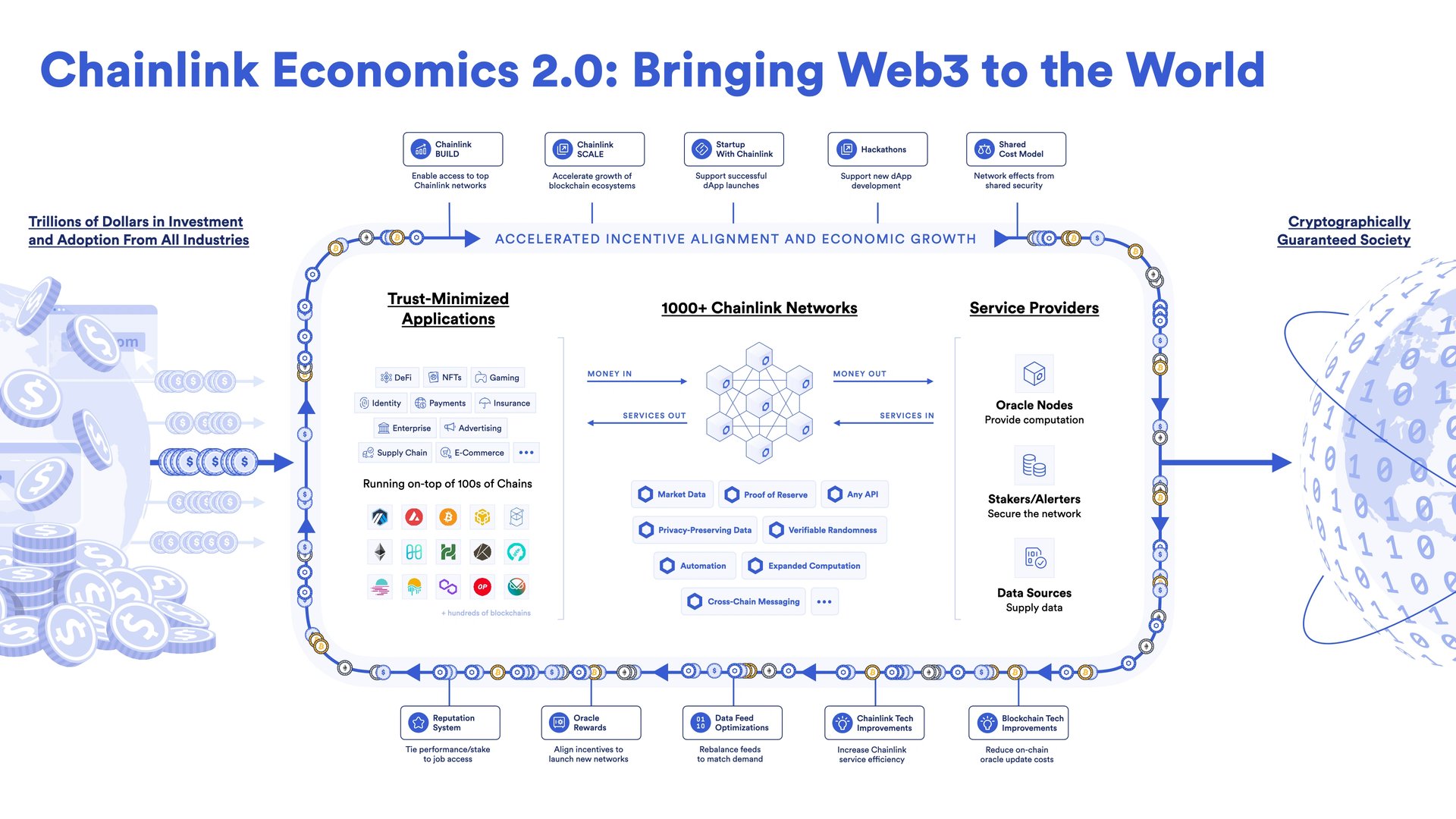
스테이킹 v0.1
스테이킹 LINK는 "장기적인 보안 및 지속가능성"을 가져온 이코노믹스 2.0 시대의 시작을 알렸습니다.
체인링크(Chainlink)가 발표한 내용에 따르면, 네트워크 스테이킹의 최종 목표는 노드 운영자 및 커뮤니티 구성원을 포함한 생태계 참여자들에게 스테이킹된 LINK 토큰으로 오라클 서비스의 보안 보장 및 사용자 보증을 강화할 수 있는 기능을 제공하는 것입니다.
LINK를 스테이킹함으로써 노드는 체인링크 네트워크에서 작업을 받고 수수료를 획득하는 능력이 향상되는 동시에, 전체 생태계는 암호경제적 보안 및 사용자 보증이 강화되는 이점을 얻게 됩니다.
스테이킹은 신뢰할 수 있는 데이터 제공에 대한 인센티브를 제공할 뿐만 아니라, 정확한 오라클 보고서를 지속적으로 생성하고 특정 목적지에 제시간에 전달하는 목표를 달성하지 못하는 성능 저하 노드에 대한 패널티 메커니즘을 허용합니다.[2][3]
베타 버전은 2022년 12월 6일에 이더리움 메인넷에서 출시되었습니다. 이는 이더리움 메인넷의 ETH/USD 데이터 피드를 지원하는 스테이킹 풀로 구성됩니다.
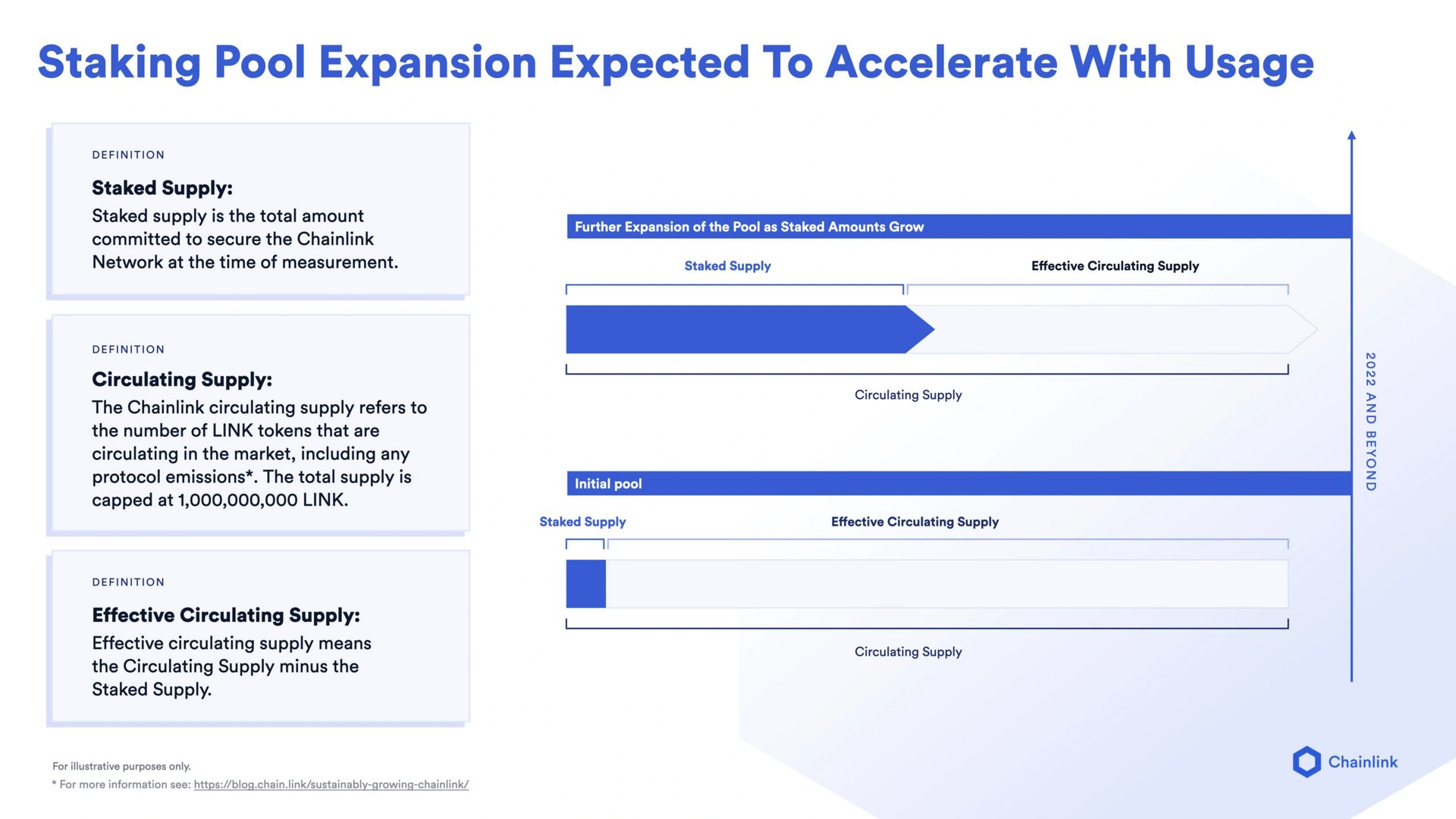
스테이커는 데이터 피드의 가동 시간을 모니터링하는 분산형 알림 시스템에 참여하여 보상을 받게 됩니다. 스테이킹 풀은 처음에는 2,500만 LINK로 제한되며, 이는 현재 유통량의 5%와 총 공급량의 2.5%를 나타냅니다. 풀은 처음에 노드 운영자 스테이커와 커뮤니티 스테이커의 두 가지 유형의 스테이커를 갖게 됩니다. 제한된 풀 공간에 대한 접근 권한을 얻을 커뮤니티 구성원을 결정하기 위해 공정한 진입 메커니즘이 만들어졌습니다. 베타 버전이 출시되면 2,250만 LINK가 선착순으로 커뮤니티 스테이커에게 할당되고, 250만 LINK는 노드 운영자 스테이커에게 할당 및 예약됩니다. 향후 풀의 보안을 강화하기 위해 서로 다른 스테이킹 할당 간의 비례 차이가 조정될 수 있습니다.[92][93]
BUILD 프로그램
BUILD는 체인링크의 새로운 경제 2.0 프로그램으로 Web3 프로젝트의 성장을 가속화합니다. 체인링크 서비스 및 기술 지원에 대한 접근성을 높이고, 스테이커와 같은 체인링크 서비스 제공업체에 수수료 및 기타 인센티브를 보장함으로써 체인링크 생태계 내 초기 단계 및 기존 기업의 성장을 촉진하고자 합니다.[87]
SCALE 프로그램
SCALE(Sustainable Chainlink Access for Layer 1 & 2 Enablement)은 지속 가능한 체인링크 접근을 위한 계층 1 및 2 지원을 의미하며, 체인링크 경제 2.0 프로그램의 일부이기도 합니다. 이는 블록체인/L2가 자체 dApps을 지원하는 Chainlink 오라클의 비용을 충당하도록 지원함으로써 온체인 생태계의 성장을 가속화하기 위한 것입니다.
블록체인과 체인링크 네트워크 모두에 대해 SCALE은 포괄적이고 이로운 경제 모델입니다.
dApp의 수수료는 결국 Chainlink 오라클 노드의 모든 온체인 비용을 충당할 수 있으며, L1 및 L2 사용자 기반이 성장함에 따라 여러 생태계에서 장기적인 지속 가능성을 가능하게 합니다. 다음 프로젝트들은 체인링크 SCALE 프로그램에 처음으로 참여한 프로젝트들 중 일부입니다: Avalanche(애벌랜치), Metis(메티스), Moonbeam(문빔), 그리고 Moonriver Network(문리버 네트워크).[88][89]
파트너십 및 협업
체인링크는 [47][47][12][13]를 포함한 광범위한 파트너십 목록을 보유하고 있습니다.
- 크레딧[14]
- 오라클[15]
- V 시스템(V Systems)[16]
- DApps Inc[17]
- 구글 클라우드(Google Cloud)[18]
- 매틱
- 고체인(GoChain)[19]
- 리저브(Reserve)[20]
- 하모니[21]
- 쉬프트(Shyft)[22]
- 헤데라 해시그래프[23]
- IOST[24]
- 스트림알(Streamr)[25]
- 오션 프로토콜[26]
- 신세틱스[27]
- 프루버블(Provable)[28]
- 셀러(Celer)[29]
- STK[30]
- 모빌럼(Mobilum)[31]
- ETHA[32]
- 카이코(Kaiko)[33]
- 완체인[34]
- 하이드로젠(Hydrogen)[35]
- bZx [36]
- 모르페우스 네트워크 (MRPH)[37]
- 웹3 재단(Web3 Foundation)[38]
- 게임덱스(GameDex)[39]
- 오픈로우(Openlaw)[40]
- 오픈제플린[41]
- 클린텍스(ClinTex)[42]
- BET 프로토콜
- 바이낸스[43]
- 이더리움 클래식[44]
- 칠즈(Chillz)[45]
- 이더리스크(Etherisc)[46]
- 스와이프(Swipe)[47]
- 0x[48]
- 아비트럼[49]
- QAN 플랫폼
- 사이퍼리움(Cypherium)[50]
- 컨텐츠(Contentos)[51]
- 블룸(Bloom)[52]
- 아이리스넷(IRISnet)[53]
- 테조스(Tezos)[54]
- 토틀(Totle)[55]
- IQ.wiki
체인링크 X SWIFT
2022년 9월 28일, 체인링크(Chainlink)는 트위터 계정을 통해 은행 간 메시징 시스템인 SWIFT와 파트너십을 맺어 전통 자산과 디지털 자산 간의 간극을 해소하고, TradFi 기관의 분산 원장 블록체인 채택을 가속화하며 자본 시장 전반의 다양한 기관에 이익을 가져다줄 것이라고 발표했습니다.[83]
SWIFT는 교차 체인 상호 운용성 프로토콜(CCIP)을 초기 개념 증명으로 사용하고 있습니다. CCIP를 통해 SWIFT 메시지가 온체인 토큰 전송을 지시할 수 있게 되어 SWIFT 네트워크가 모든 블록체인 환경에서 상호 운용될 수 있도록 지원합니다.
추가 협력
2023년 6월, 체인링크(Chainlink)와 스위프트(Swift)는 다양한 블록체인 네트워크 간의 연결성을 개선하기 위한 목표를 발표했습니다. DTCC, ANZ, BNP 파리바(BNP Paribas), BNY 멜론(BNY Mellon), 시티(Citi), 클리어스트림(Clearstream), 유로클리어(Euroclear), 로이드 뱅킹 그룹(Lloyds Banking Group)과 같은 주요 금융 기관들이 이 노력에 동참했습니다. 목표는 스위프트의 인프라가 어떻게 다양한 블록체인에서 토큰화된 자산의 원활한 이전을 가능하게 할 수 있는지 탐구하는 것입니다. 체인링크의 역할에는 공공 및 사설 블록체인 간의 연결성 향상과 실제 상호 운용성 증진이 포함됩니다. 이러한 계획은 다양한 네트워크에서 토큰화된 자산 추적의 단편화라는 과제를 해결합니다. 연결을 확립함으로써 금융 기관은 운영을 간소화하고, 마찰을 줄이며, 자산 관리 효율성을 개선하고자 합니다. [99][100]
“매우 단편화된 생태계에서 금융 기관이 모든 플랫폼에 개별적으로 연결하는 것은 단순히 실행 가능하지 않습니다. 이러한 단편화를 극복하는 것이 시장의 장기적인 확장성에 중요한 역할을 할 것입니다.” - 톰 자샤크(Tom Zschach), 스위프트 CIO.
체인링크 X 코인베이스 클라우드
2022년 9월 28일, 체인링크(Chainlink)는 코인베이스 클라우드(Coinbase Cloud)와 파트너십을 맺고 NFT 바닥 가격 피드를 출시한다고 발표했습니다. 이를 통해 개발자는 고품질 가격 데이터와 최적의 유동성 프로필을 사용하여 DeFi 사용 사례 등 다양한 분야에서 고유한 스마트 계약을 배포할 수 있습니다.[85]
체인링크 X IQ.wiki (구 에버피디아)
2020년 11월, Associated Press(어소시에이티드 프레스)는 체인링크 인프라를 사용하는 IQ.wiki (구 에버피디아) OraQle을 이용하여 2020년 미국 대통령 선거 결과를 최초로 블록체인에 게시했습니다. [56]
체인링크 사업 개발 책임자인 Daniel Kochis(다니엘 코치스)는 이 역사적인 사건에 대해 다음과 같이 말했습니다.
“이 강력한 기술을 더욱 접근 가능하게 만드는 것이 그 잠재력을 최대한 실현하는 데 중요합니다. 그리고 AP의 선거 결과를 블록체인에 최초로 게시하는 것은 그 여정의 중요한 이정표입니다.”
체인링크(Chainlink) X 구글 클라우드(Google Cloud)
2021년 8월, 체인링크(Chainlink)는 구글 클라우드(Google Cloud)와의 파트너십을 통해 완전히 분산된 기상 데이터 피드를 출시했습니다.
체인링크 X 아비트럼
이더리움 dApp 개발을 위한 가장 인기 있는 2계층 확장 솔루션인 아비트럼과 선도적인 오라클 서비스 제공업체인 체인링크는 아비트럼 원에서 체인링크 오토메이션 출시를 발표했습니다. 개발자는 스마트 계약을 모니터링하고 체인링크의 트랜잭션 매니저를 사용하여 함수를 실행할 수 있는 분산 노드 네트워크를 통해 안정적이고 효율적인 자동화를 갖춘 정교한 dApp을 구축할 수 있습니다. 광범위하게 테스트된 이 트랜잭션 매니저는 논스 관리, 가스 스파이크 및 네트워크 재구성을 처리합니다.[97]
체인링크 x 트루USD
트루USD는 체인링크 증명 준비금(Chainlink Proof of Reserve)을 사용하여 프로그래매틱 방식으로 발행을 관리하고 이를 통해 최초로 USD 기반 스테이블코인으로 자리매김할 것이라고 발표했습니다. 이를 통해 새로운 TUSD가 충분히 담보되었는지 자동으로 검증할 수 있습니다. TUSD의 준비금 데이터는 미국의 독립 회계법인인 The Network Firm LLP(TNF)가 집계하며, 체인링크를 통해 온체인으로 전달되어 TUSD 스마트 계약에서 사용됩니다. [98]
“트루USD 스테이블코인의 투명성과 검증 가능성을 높이기 위해 체인링크 증명 준비금을 사용하게 되어 기쁩니다. 업계 표준 탈중앙화 오라클 네트워크인 체인링크는 TUSD가 항상 오프체인 법정 준비금으로 담보될 수 있도록 보장하여 TUSD의 신뢰와 투명성에 대한 약속을 더욱 강화합니다.” - 라이언 크리스텐슨(Ryan Christensen), 아치블록(Archblock)(이전 명칭: 트러스트토큰(TrustToken), TUSD 발행사) CEO
체인링크 해병대(ChainLink Marines)와 밈
제품의 대중적 채택을 위해 끊임없이 노력하는 열정적인 체인링크(ChainLink) 매니아 그룹은 체인링크 해병대(ChainLink Marines)로 알려져 있습니다. 2020년 4월까지 48,000개 이상의 주소가 100~10,000 LINK를 보유하고 있었습니다.[58]
2020년 8월, 링크 해병대(Link Marines)는 제우스 캐피탈(Zeus Capital)의 보고서를 거부했습니다. 이 보고서는 해당 프로젝트를 공허한 소프트웨어(vaporware)라고 부르며 체인링크(ChainLink) 가격이 0.07달러까지 떨어질 것이라고 경고했습니다.[59] 체인링크(ChainLink)는 2018년 9월 몰락한 와이어카드(Wirecard)와 세러노스(Theranos)와 비교되었습니다. 제우스 캐피탈(Zeus Capital) 페이지의 또 다른 트윗은 링크 해병대(Link Marines)가 디지털 자산을 계속해서 부풀리도록 돈을 받고 있다고 주장했습니다. 또한, 그들의 궁극적인 목표는 무지한 투자자들의 돈을 가져가는 것이라고 합니다.[60]
밈(Meme)은 체인링크(ChainLink) 커뮤니티의 중요한 부분이며, 개구리 페페(Pepe the Frog)는 비공식 마스코트로 사용됩니다. 일부 링크 해병대(Link Marines)는 Opensea에서 체인링크(ChainLink) 밈 NFT를 사고 팝니다.
체인링크 신(Chainlink God)은 암호화폐 트위터(Crypto Twitter)에서 가장 인기 있는 인물 중 한 명입니다.
유명 인사
크리스 험프리스(Kris Humphries)
NBA 선수 크리스 험프리스(Kris Humphries)는 체인링크(ChainLink)의 투자자이자 지지자입니다. 그는 2020년 4월부터 체인링크에 대한 트윗을 시작했으며 장기적인 투자라고 말합니다. 크립토슬레이트(CryptoSlate)와의 인터뷰에서 크리스 험프리스(Kris Humphries)는 NBA 선수로서 데이터의 가치를 이해하고 그것을 체인링크의 가치(오프체인 데이터를 블록체인에 올리는 것)와 연결시킨 것이 투자 및 홍보의 계기 중 하나라고 설명했습니다.[61][62]
“NBA에서 활동하는 동안 데이터가 플레이 개발과 전반적인 팀 전략에서 차지하는 역할이 점점 커지는 것을 목격했습니다. NBA를 주목하는 사람이라면 3점슛 증가와 골밑 공격 강화 추세를 알고 있을 것입니다. 이러한 관점은 제가 데이터의 가치를 이해하는 데 도움을 주었고, 체인링크를 포함한 블록체인 분야에서 제가 좋아하는 프로젝트의 유형을 형성했습니다.”
그가 투자하게 된 또 다른 요인은 체인링크 팀의 강한 직업윤리와 성과였습니다.[63]
“NBA에 입단하면서 저는 모든 사람보다 열심히 일하겠다고 스스로에게 말했습니다. 그러다 디르크 노비츠키(Dirk Nowitzki)를 만났습니다. 그는 제가 노력이 무엇을 의미하는지, 특히 위험이 높을 때 노력의 보상에 대한 이해를 바꿔놓았습니다. 체인링크 초기에는 기술적인 부분에 집중하는 소규모의 재능 있는 팀이었습니다. 2017-2018년 붐-버스트 시기에 다른 프로젝트들이 화려한 비디오를 만들고 유명인을 고용했을 때도, 체인링크는 마케팅 팀조차 없었던 것 같습니다. 그러한 노력과 집중이 이제 결실을 맺고 있습니다.”
데이비드 포트노이 (David Portnoy)
2020년 8월, 데이비드 포트노이는 25만 달러 상당의 비트코인(Bitcoin)과 미국 달러를 체인링크(ChainLink)의 LINK 토큰에 투자했다고 발표했습니다. 그는 2020년 8월 15일 자신의 170만 명의 팔로워들에게 "$LINK to the moon"이라고 트윗하기도 했습니다. 2020년 8월 21일, 포트노이는 2만 5천 달러의 손실을 보고 그의 모든 암호화폐(cryptocurrency)를 매도했다고 발표했습니다.[64][65][66][67]
개발 현황
체인링크, 솔라나에 CCIP 출시
2025년 5월, 체인링크(Chainlink)는 v1.6 업그레이드를 통해 이더리움 가상 머신(EVM)이 아닌 블록체인에 처음으로 배포하면서 솔라나에서 자체 크로스체인 상호운용성 프로토콜(CCIP)을 출시했습니다.
이 통합은 솔라나와 이더리움, BNB 체인, 아비트럼과 같은 네트워크 간의 안전한 크로스체인 자산 및 데이터 전송을 가능하게 하는 것을 목표로 합니다. 이 업그레이드를 통해 메이플 파이낸스, 시바 이누, 백드 파이낸스(Backed Finance)와 같은 프로젝트는 체인링크의 크로스체인 토큰(CCT) 표준을 사용하여 토큰화된 자산을 솔라나의 생태계로 확장할 수 있습니다.
이러한 토큰들은 총 시가총액이 190억 달러가 넘습니다. CCIP의 v1.6 업데이트는 거래 비용을 줄이고 수백 개의 블록체인에 걸쳐 확장하기 위한 아키텍처를 간소화합니다. [105]
체인링크-마스터카드 파트너십
2025년 6월, 체인링크(Chainlink)는 마스터카드(Mastercard)와 파트너십을 맺어 마스터카드 연계 서비스를 통해 카드 소지자가 암호화폐를 직접 구매할 수 있도록 했습니다. 이번 협력은 마스터카드의 안전한 결제 네트워크와 체인링크의 분산형 오라클 인프라를 통합하여 기존 금융 사용자의 암호화폐 접근성을 간소화하는 것을 목표로 합니다. [106]
이 계획을 통해 사용자는 마스터카드로 디지털 자산을 구매할 수 있으며, 체인링크의 크로스체인 상호운용성 프로토콜(CCIP)을 활용하여 결제 시스템과 블록체인 네트워크 간의 안전하고 안정적인 데이터 전송을 가능하게 합니다.
두 회사 모두 이 파트너십이 암호화폐 채택의 어려움을 줄이고 블록체인 기반 금융 애플리케이션에 대한 신뢰를 높일 수 있는 잠재력을 강조했습니다. [106]
팀 및 자문위원
- Sergey Nazarov (세르게이 나자로프) - 최고경영자
- Steve Ellis - 최고기술책임자
- Dimitri Roche - 소프트웨어 엔지니어
- Alex Kwiatkowski - 소프트웨어 엔지니어
- John Barker - 소프트웨어 엔지니어
- Dan Kochis - 글로벌 사업개발 및 파트너십 총괄
- Adelyn Zhou - 마케팅 이사
- Brendan Magauran - 운영 이사
- Thomas Hodges - 통합 엔지니어
- Rory Piant - 커뮤니티 매니저
- Ari Juels - 기술 자문위원
- Andrew Miller - 기술 자문위원
- Evan Cheng (에반 청) - 기술 자문위원
- Tom Gonser - 자문위원
- Hudson Jameson (허드슨 제이미슨) - 기술 자문위원
- Jake Brukhman - 자문위원
- Brian Lio - 자문위원
잘못된 내용이 있나요?
